Content
- 1 Features of the vesicle
- 2 Planting the bladder in open ground
- 3 Bladder care
- 4 Reproduction of the bladder
- 5 Bubbles in winter
- 6 Types and varieties of bladderworm with photos and names
- 7 Planting the bladder
- 8 Bladder care
- 9 Pruning and shaping the vesicle
- 10 Bladder infections
- 11 Wintering of the bladder
- 12 How to propagate the bladder
- 13 Landing
- 14 Bladder care
- 15 Pest and disease control
- 16 Varieties
- 17 Application in landscape design
The deciduous shrub (Physocarpus) is a member of the rose family. The Latin name of such a plant consists of 2 roots of the ancient Greek language, namely: "physo" - "bubble" and "carpos" - "fruit". There are 14 species in this genus. In the wild, the vesicle can be found in North America and East Asia. When grown in a garden, this shrub is distinguished by its unpretentiousness, as well as the fact that it is able to maintain its spectacular appearance throughout the entire growing season. Also, this shrub is fast-growing and resistant to air pollution. Such a plant is grown as a single plant and is used in landscape design. However, the hedge from the bladderwort looks most impressive.
Features of the vesicle

The sprawling bush of the bush consists of drooping branches that form a lush spherical crown. In an adult shrub, peeling of the bark occurs, and in wide strips. In height, it can reach 300 centimeters. Three to five-lobed leaf plates in shape resemble viburnum leaves. Simple white flowers have many stamens. They are part of hemispherical inflorescences, which can reach 5-7 centimeters in diameter. Lush bloom occurs early in the summer. The fruits of such a plant also look quite impressive, they are swollen leaflets that, when ripe, turn red. Only 2 types of vesicle are cultivated, while there are several spectacular varieties, the leaf plates of which have different colors.
Planting the bladder in open ground
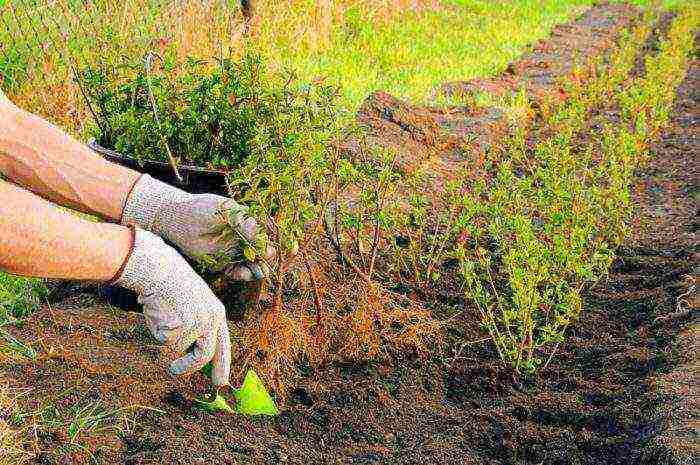
What time to plant
If you managed to buy seedlings with a closed root system in a nursery or garden center, they can be planted in open soil at any time of the year (but not in winter). If the purchased seedlings have an open root system, then for planting them, you should choose spring, and best of all, autumn. For planting such a plant, a well-lit, open place is suitable, next to which large trees will not grow. In the event that the variety has a green leaf color, then such a shrub can grow normally in a shaded area. The vesicle is not picky about the soil, however, it must be well-drained, and lime must be included in its composition. If you want it to have the most decorative look, then you should choose a loose loamy soil saturated with nutrients.
How to plant
When preparing the planting hole, it should be remembered that its size should be such that a layer of soil saturated with nutrients (or an earth mixture consisting of peat, turf, earth and sand) can fit in it, while the root collar of the seedling after planting should be flush with the surface of the site. In this regard, it is recommended to prepare a hole by digging it and filling it with fertile soil half a month before the planned planting day, in this case the soil will have time to settle well. The seedling is placed in the planting hole together with an earthen lump, while remember that fertilization should not be applied to the soil during planting, since the young plant is simply not able to assimilate it normally. Then the hole will need to be filled with soil mixture (the composition is described above) or soil saturated with nutrients. The planted shrub needs abundant watering. If after watering the earth settles, then you will need to add it. The first days should be monitored so that the near-stem circle of the vesicle is constantly slightly damp. The surface of the site should be covered with a layer of mulch (humus or peat).
Bladder care
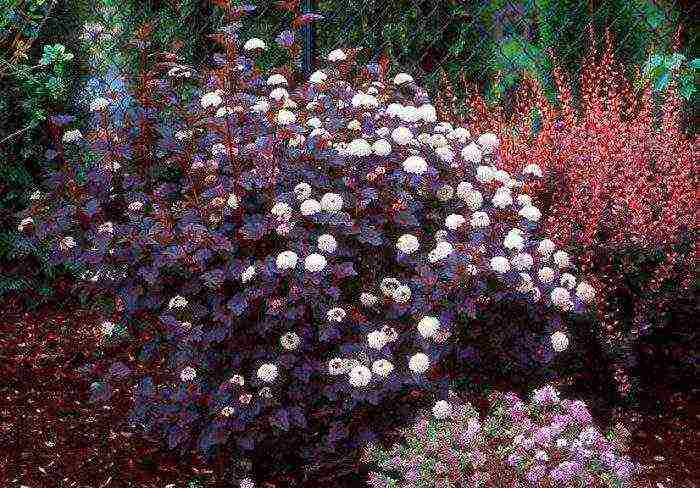
When caring for such a plant, it is very important to water it on time, as it reacts extremely negatively to drought. When watering, make sure that the liquid does not get on the surface of the leaf plates and inflorescences, as this can lead to burns. In this regard, this procedure is recommended to be performed early in the morning or in the evening. In the summer, during the hot period, watering will need to be carried out about a couple of times a week, while at the same time 4 buckets of water should go to 1 bush. Observe the state of the bladder leaves, because not only drought, but also waterlogging of the soil can harm it. In the event that the site is not covered with mulch, then every time after the shrub is watered, it is necessary to loosen its surface and weed.
You need to feed the plant a couple of times a year (in spring and autumn). In spring, the plant should be fed with the following nutrient mixture: for 1 bucket of water, take a five-hundred-gram can of mullein, as well as 1 large spoonful of urea and ammonium nitrate. For 1 adult bush, 1.5 buckets of such a solution are taken. In autumn, one and a half buckets of nutrient solution should be poured under each bush, consisting of 10 liters of water and 2 large spoons of nitroammophoska.
Pruning
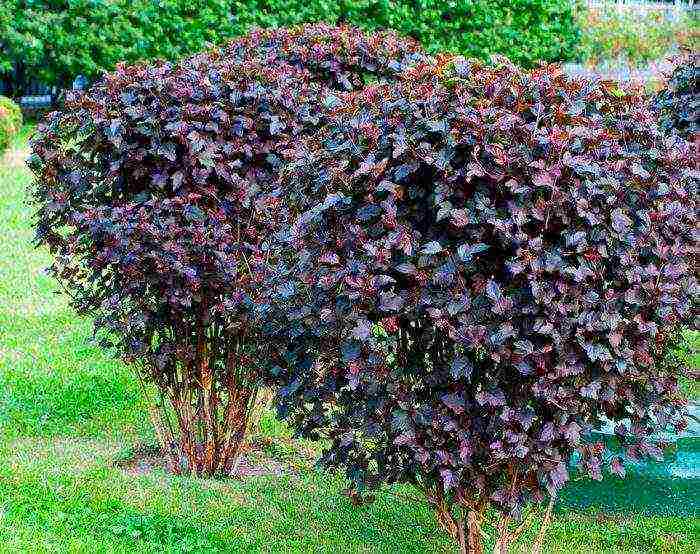
This shrub needs systematic sanitary and formative pruning. In spring, it is imperative to prune for sanitary purposes; for this, all injured, diseased, frost-affected stems and branches, as well as those that grow inside the bush, are cut off. By pruning the vesicle in the fall, you prepare it for the coming winter. Pruning to form a crown can be done in the fall, but experienced gardeners recommend doing it in the spring. In order for the bush to have the shape of a fountain, you need to cut off all the thin stems at the base, leaving 5 or 6 of the most powerful ones, which must be shortened a little. If you want the bush to be wide, you need to cut it at a height of 50 centimeters. When the shrub is 6 years old, rejuvenating pruning is performed on the stump. On thick stems, the places of the cuts should be smeared with garden var.
Transfer
In some cases, it becomes necessary to transplant this plant, for example, you need to transfer it to another place. If the shrub is already adult, then it should be transplanted in early spring, before the buds swell, or in the autumn, when the leaf fall ends. The bush is transplanted with a sufficiently voluminous earthen lump, while first pruning is done, during which the injured, diseased and thickening stems are cut off, and the remaining ones should be shortened to 0.2–0.3 m.Thanks to this, you will be able to reduce the load on the root system, because during adaptation it will be extremely difficult for it to feed an adult plant. The transplant is carried out in almost the same way as the planting, only it should be taken into account that the vesicle in this case is already an adult. The transplanted bush must be watered using a solution of Heteroauxin or Kornevin, and you also need to spray the leaf plates with Epin or Ecogel-antistress.
Diseases and pests
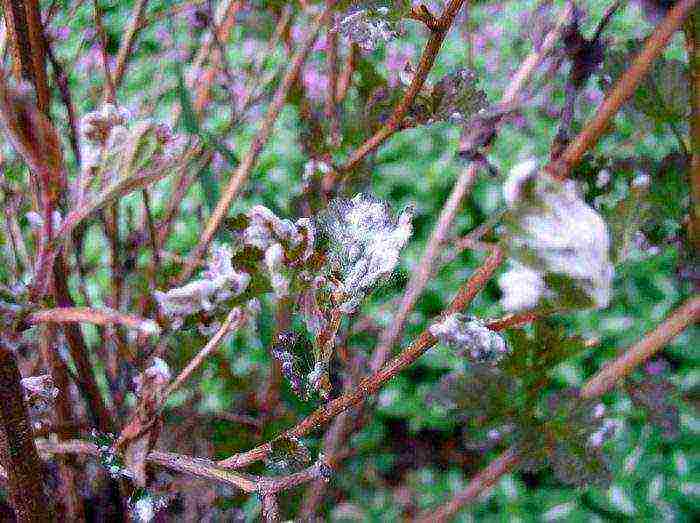
It is quite simple to plant and grow a vesicle, and the gardener will also be pleased that it has a very high resistance to pests and various diseases. However, if the soil does not get nutrients, then the plant develops chlorosis, due to which the apical stems dry out and young leaf plates turn yellow. If you notice signs of this disease, then you should spray the foliage or water the bush itself under the root with a solution of Ferrylene, Antichlorosis, Ferovit, but experienced gardeners recommend using Iron Chelate. As a rule, after this procedure, the vesicle recovers very quickly.
Reproduction of the bladder

The bladder can be easily propagated in a vegetative way, namely by cuttings, layering, as well as dividing the bush. The generative (seed) method of reproduction is also suitable for this. Seeds are sown in spring or autumn, while first they must be stratified within 30 days. However, you should be aware that shrubs grown in this way rarely retain the rich color of the leaves, which is inherent in the parent plant. And the cultivation of a vesicle from seeds is a rather laborious process. In this regard, it is recommended to resort to vegetative methods for its reproduction.
Cuttings
Cuttings should be harvested before the bush blooms. To do this, cut off the green shoots of this year. The length of the cuttings can be from 10 to 20 centimeters, and each of them should have 2 or 3 internodes. All leaf plates at the bottom of the cutting must be cut off, and those at the top are shortened by ½ part. Prepared cuttings must be immersed in a solution of a means of stimulating root formation (for example, Kornevin). Then they are planted in a training bed in a mixture of peat and sand. They are watered and covered with polyethylene film. It is very simple to care for the cuttings, they must be watered and systematically ventilated on time. In winter, rooted cuttings need shelter, and in spring they can be planted in a permanent place.
How to propagate by layering

This breeding method is the simplest and most effective. In the springtime, the most powerful and absolutely healthy shoot should be selected, which must necessarily grow outward. All leaf plates should be cut off from it, leaving only those growing at the very top. Then this stem is placed in a previously prepared groove, the depth of which should be about 12 centimeters, then it is fixed using a brace made of wood (you can take hairpins for hair), then the groove must be filled with soil. Throughout the growing season, the cuttings will need timely watering, weeding and loosening of the soil surface. By the onset of the autumn period, the cuttings will have to give roots, and it must be separated from the parent bush and covered for the winter.
How to propagate by dividing a bush

By dividing the bush, it is best to propagate the bladderwort. This procedure is performed in spring or autumn. However, if you have experience and certain skills in this matter, then you can divide the bush in the summer. In order for this procedure to end successfully, it must be carried out very quickly, because the root system, which is in the fresh air, should not dry out in any case.
Bubbles in winter
Autumn care
In the autumn period, this shrub looks especially impressive, because it is at this time that the foliage is painted in different colors. It has a relatively high frost resistance and in winter, as a rule, only those branches that have not had time to ripen freeze. But it should be borne in mind that rooted cuttings, like young specimens, need shelter for the winter.
Preparation for wintering
In the event that forecasters foreshadow a very frosty winter, then adult vesicle bushes should also be covered. To do this, you need to carefully pull off the bush with twine, and then "put" on it a cone made of roofing material or loosely wrap it with lutrasil. However, first you need to cover the surface of the trunk circle with a layer of mulch (peat), the thickness of which should be from 5 to 8 centimeters. Young shrubs should be cut off, their trunks should be mulched, and then covered with spruce branches.
Types and varieties of bladderworm with photos and names
At the moment, only 2 species of the vesicle are cultivated, as well as their varieties and varieties.
Amur bubblegum (Physocarpus amurensis)
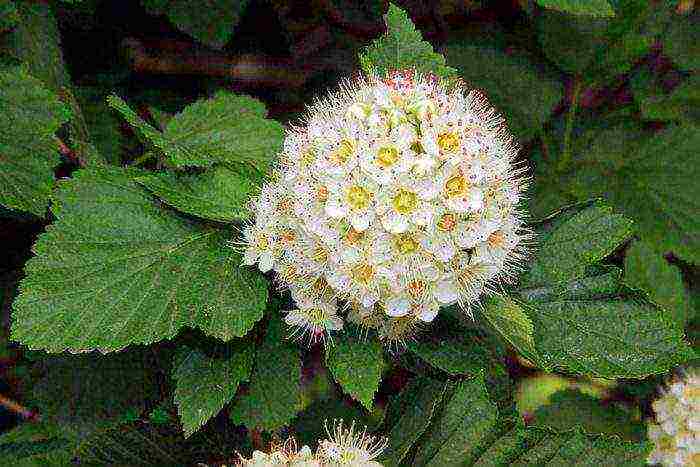
This species can be found in natural conditions in North Korea, North China and the Far East, while it prefers to grow in mixed forests. The height of such a shrub with a spherical crown is about 300 centimeters. Young stems are brownish-red and smooth, while on old trunks, the bark is peeled off in longitudinal stripes. The three to five lobed leaf plate has a heart-shaped base and is about 10 centimeters long. Their front surface is dark green, and the seamy surface is whitish-gray, because star-shaped felt hairs are located on it. Corymbose inflorescences consist of 10-15 white flowers with one and a half centimeter diameter. Flowering lasts approximately 20 days. The fruit is a swollen leaflet that turns red when ripe. This species is highly frost-resistant. It is used to create hedges, as well as in group and single plantings. Cultivated since 1854. The most popular forms:
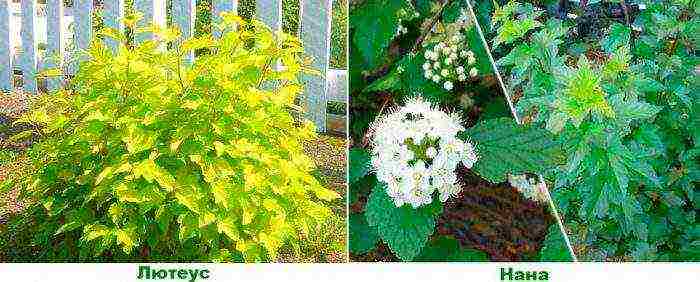
- Luteus... In the summer, the leaf plates are painted in a deep yellow color, and in the autumn they turn bronze.
- Aureomarginate... The leaf blades have a dark golden edging.
- Nana... Such a dwarf shrub has dark green monochromatic leaf plates.
Bubble plant (Physocarpus opulifolius)

The homeland of this species is the eastern part of North America, while it prefers to grow in undergrowth and on river banks. This shrub with a lush hemispherical crown in height can reach 300 centimeters. Elliptical three to five lobed leaf plates have an elongated large middle lobe and a serrated edge. Their front surface is green, and the seamy side is painted in a paler shade, sometimes it can be pubescent. Small (about 1.2 cm in diameter) flowers have pink or white color, and red stamens. The fruit is a swollen, assembled pale green leaflet that turns red when ripe. This type can be used to create a hedge, as well as in single or group plantings. Cultivated since 1864 The most popular varieties:

- Darts Gold... The height of a dense and wide bush can be up to 150 centimeters. Yellow leaf plates turn greenish-yellow in summer. The racemose inflorescences consist of white or pink flowers.
- Diablo (red-leaved)... The height of the bush is about 300 centimeters. The color of its foliage is purple or dark red. If the bush is grown in a shaded place, then its leaves will be green with a purple tint, and when grown in a sunny place, they have a red color. In autumn, the color of the foliage does not change. This variety is the most popular.
- Red Baron... The height of the bush is about 200 centimeters.The bare oval three-to-five-lobed leaf plates reach 7 centimeters in length and have a serrated edge. They are colored in a spectacular dark red and are narrower than Diablo's vesicle. Umbellate inflorescences consist of white flowers with a pink tint, reaching a diameter of 5 centimeters. The fruits of red color also look quite impressive, which include from 3 to 5 pointed sacs. This variety is among the most valuable.
- Lady in Red... The bush can reach a height of 150 centimeters. This variety was bred by breeders from England. The leaves of a deep red color gradually darken. The color of delicate flowers is white-pink.
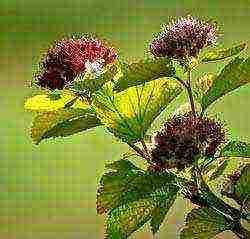 Among the shrubs, there are few that would be as beneficial as a bubblegum, combining decorativeness, ease of cultivation and undemanding care. Look at the photo, how can you pass by such a handsome man, because he does not lose his charm even in winter. Planting will not take much time, but you will admire the decoration of the bush for many years.
Among the shrubs, there are few that would be as beneficial as a bubblegum, combining decorativeness, ease of cultivation and undemanding care. Look at the photo, how can you pass by such a handsome man, because he does not lose his charm even in winter. Planting will not take much time, but you will admire the decoration of the bush for many years.
Varieties and varieties of the bladder
Sometimes the vesicle is mistakenly called spirea, but this is a misconception. These two plants belong to the same family, but belong to different genera. In an adult plant, the bark is separated from the shoot in wide stripes. The fruits of the bladder are similar to the bladder, which gave the name to the plant. In decorative gardening, varieties of the viburnum vesicle are used. These varieties are combined into groups according to the color of the foliage.
Varieties with red color leaf blade:
- Diablo;

Diablo variety
- Summer Wine;

Summer Wine variety
- Red Baron;
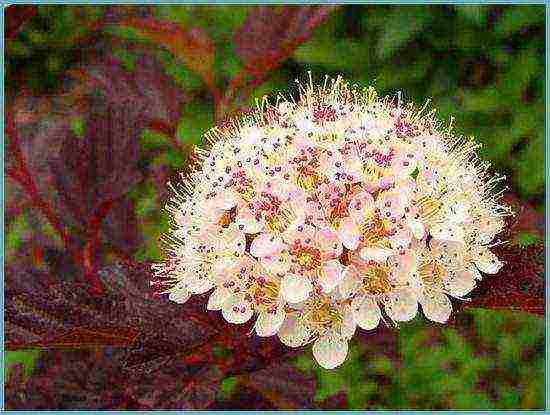
Red Baron variety
- Schuch.

Schuch variety
Varieties having yellow leaf blade:
- Luteus;
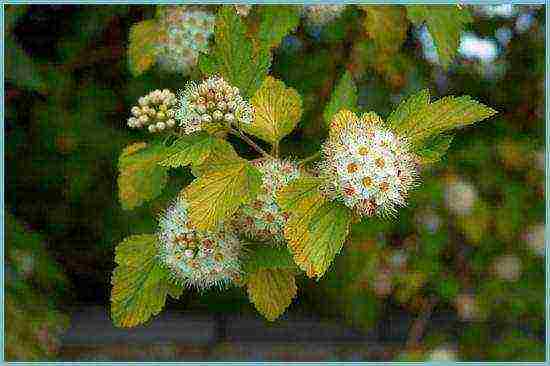
Luteus cultivar
- Darts Gold;
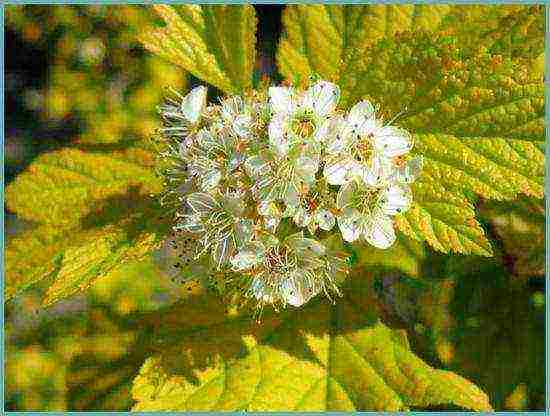
Darts Gold grade
- Nugget.
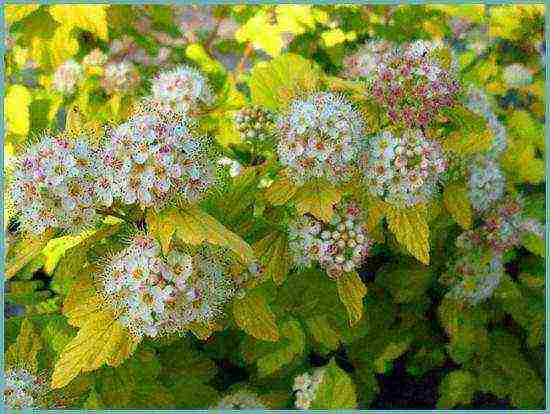
Nugget variety
Varieties with double color:
- Center Glow;

Center Glow variety
- Coppertina.
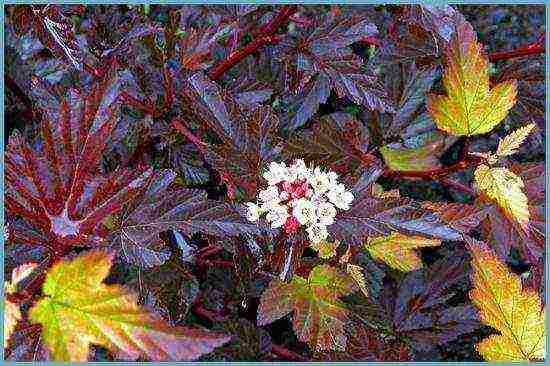
Coppertina cultivar
Landing
Of course, planting a vesicle, like any plant, begins with choosing a suitable place. The bubble plant grows well both in the sun and in the shade. It grows poorly on soils with high groundwater levels and high lime content. Such soil can provoke chlorosis or root rot, which will lead to the death of the shrub. The plant does not impose special conditions on soil fertility.
You can safely plant the plant as a hedge along the road, since the bubble plant tolerates the gas pollution of the city air very well.
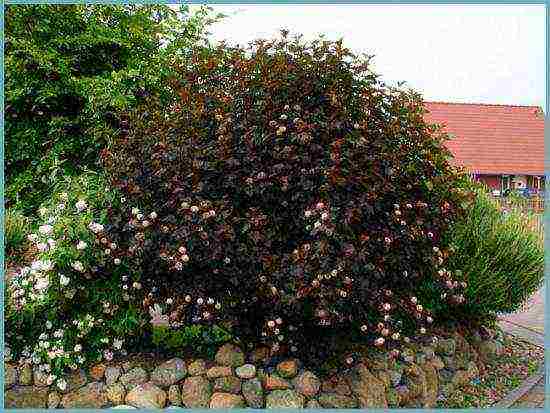
The bladder is completely unpretentious to the landing site
It is better to purchase a plant for planting with a closed root system in nurseries. So you will have a guarantee of purchasing a varietal seedling. The container seedling can be planted at any time, excluding the winter months. Planting material with an open root system is planted in spring or autumn. Autumn planting is preferable, since rooting conditions are more favorable than in spring.
There are no tricks when planting: a hole is dug so that the root collar is at ground level. It is filled with fertile soil composition and is well watered. From above it is mulched with humus, peat or just dry soil.
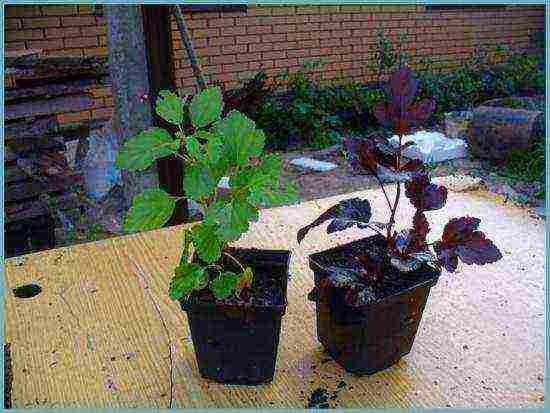
Bubble seedlings
To get a hedge from a bubble, young seedlings are planted in a two-row way in a checkerboard pattern. A distance of 35 cm is left between the rows, and 45 cm in a row. Such a hedge can be formed by cutting, giving it the appearance of a rectangle of a meter height. A free-growing hedge, limited only from the sides by pruning, will grow 1.8 - 2.5 m, depending on the variety planted.
Advice. Shrub varieties with golden or purple foliage, such as Diabolo or Darts Gold, are best planted in sunny areas, since the decorative foliage decreases in the shade.
Hassle-free care
Despite the fact that the vesicle belongs to unpretentious plants, this does not mean that it is worth planting and forgetting about it.The shrub has a lifespan of 30 years. Under favorable conditions, the shrub during the growing season is able to add in breadth and height up to 45 cm, in the second year only flowering shoots form on the regrown shoots, therefore, stimulating pruning and crown formation is vital for the bush. The plant tolerates this procedure very well and recovers quickly. For the winter, it does not require any additional shelters, the bubblegum is very winter-hardy, only in severe frosts the tips of the shoots can freeze.

The bladder does not require special care
Watering
Special attention to soil moisture is required for young, only planted plants, because their survival rate depends on this. In general, the frequency and abundance of watering depends on the age, soil composition and climatic zone of growth.
- When the bubble grows on loam and high temperatures in the summer, watering will be required regularly twice a week, four buckets of water per adult bush.
- On heavy clay soils, it is important not to overmoisten the soil so as not to provoke the death of the root system.

Water in moderation
Pruning
Pruning can be divided into sanitary and formative. Sanitary pruning is carried out in the spring, its task is to remove broken or frozen branches of the plant. Formative pruning is best done in the spring, but can also be done in the fall.
Free-growing vesicle bushes have the shape of a crown in the form of a fountain. In a plant, the first to wake up and always start growing are the upper buds. If you want a wide bush with many shoots, cut the branches at a height of half a meter. The fountain-like shape is given by cutting all thin shoots down to ground level. There should be about five of the strongest shoots in the bush, they are additionally shortened to a height of one and a half meters from the ground. Radical pruning is carried out every 4 - 5 years, leaving hemp 15 - 20 cm from the ground.
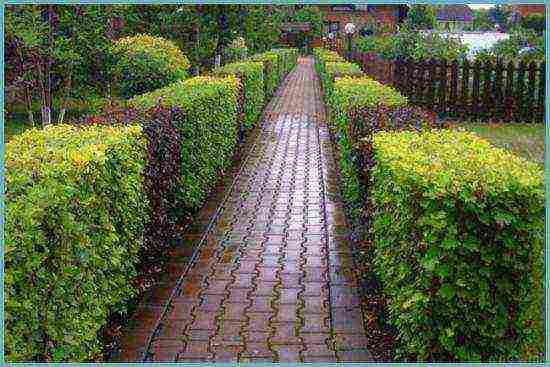
Bubbles looks great as a hedge
Pruning begins when the plant reaches the age of three. To make the bush more compact, you can shorten young shoots 2-3 times during the growing season.
Advice. If, for any reason, an adult bush needs to be transplanted to a new place, do it in the fall, after flying around the foliage. Remove excess branches, and shorten the rest by 30 cm. An adult bush is planted in the same way as a young plant.
Fertilizing and feeding shrubs
They feed the bladder twice a season. In the spring, fertilizers containing an increased dose of nitrogen will be required for the growth of vegetative mass. This should be done at the time of bud break. Apply an infusion of mullein or bird droppings at the rate of half a liter per bucket of water. In the fall, a solution of nitroammofoska is used, approximately a matchbox of fertilizer on a bucket of water. For adult vesicle bushes that have reached 10 years or more, the dose of top dressing is increased by half.
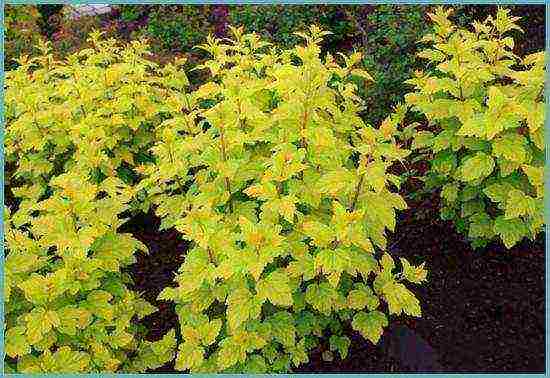
Feed the crop 2 times a year
The bubble plant responds perfectly to the mulching of the trunk circle with organic materials. Mulch creates favorable conditions for plant roots: the soil does not overheat, structure and breathes, moisture surges are minimized. Mulch will save you from constant loosening and weeding.
Methods for reproduction of the vesicle
It is easy to propagate the bladder by yourself - by layering or by cutting, like currants, or by dividing the bush. The seed method is also possible, but the fact is that seedlings rarely inherit the characteristics of the mother plant from which the seeds were taken. Moreover, this is a troublesome occupation. The vegetative method of plant propagation is more reliable and gives a consistently fast result.
Reproduction by layering... This is the least time consuming option. Take a healthy and strong shoot in the spring, tear off the foliage, leaving only the top intact. Now we put this shoot in a pre-dug trench, 10-15 cm deep and press it to the ground with a wire or wood hairpin.Bend the top with the leaves vertically up and tie it to a wooden peg. The buried part of the shoot will give roots. Now the main task is to timely moisten the soil so that the young roots get stronger by the fall. The next year, in early spring, you can plant a young bush in a permanent place.
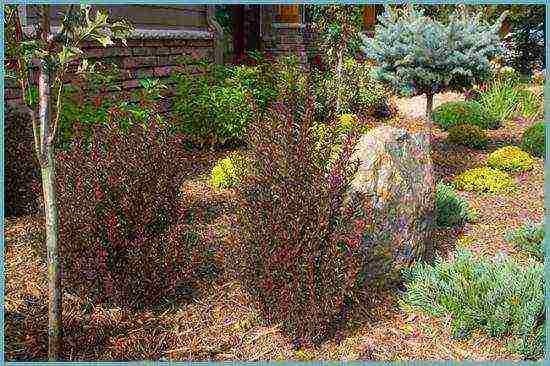
Bubble plant in landscape design
Propagation by cuttings. For this purpose, young shoots of the current year are cut with a length of about 20 cm.At the crown, the foliage is shortened by half, the rest is removed completely. The lower part can be slightly scratched to quickly form the callus, which will subsequently take root. For a day, we put the cuttings in a bucket of water, to which we add a drug that stimulates the formation of roots or a spoonful of honey. Now you can plant the cuttings in the school.
The soil must breathe, so we prepare for the cuttings in advance and add soil from a mixture of peat and sand. We cover the school with a film and do not forget to moisten, ventilate and spray. In winter, cuttings need shelter, and in spring they can be planted in a permanent place.
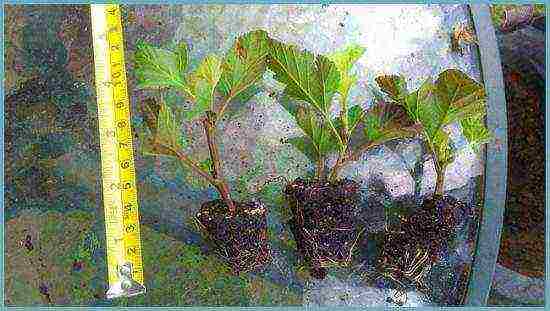
Bladder cuttings
To propagate the bladderworm by seeds, they must be stratified within a month before planting. Seeds are planted to a depth of 2 - 3 cm.
Diseases and pests
Another advantage of the vesicle is that it is practically not affected by diseases and pests. Chlorosis of the leaves can rarely be observed - when the tips of the shoots dry out and the foliage turns yellow, the veins remain green. This is due to a lack of trace elements in the soil: elements of iron, magnesium or nitrogen, or overmoistening of the root ball. Chlorosis can be caused by viruses and microorganisms that are carried by pests. Applying complex fertilizers with irrigation or spraying the foliage with chelated compounds will help the bladder to restore health.
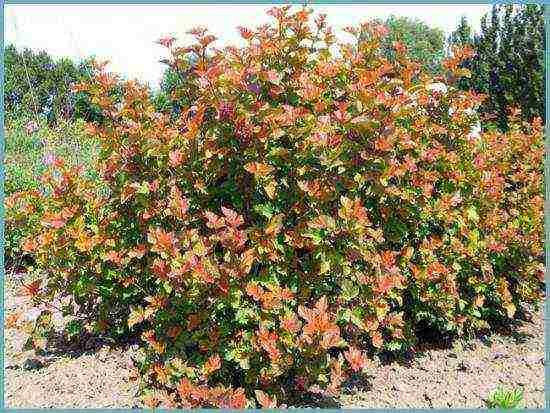
Bladder infections mainly arise from improper care
The gallbladder is good as a solo plant, perfect as a living enclosure in mixed group plantings. Even the bark is decorative in this shrub. Leaves and flowers that change shades during the season will add a contrasting color variety to the green decoration of the garden area.
Bubble in the garden: video
Growing a vesicle: photo
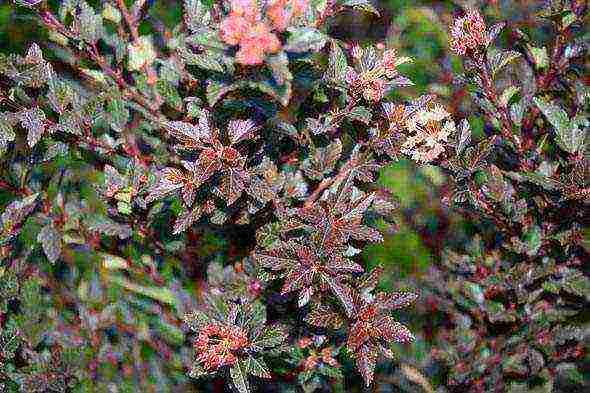
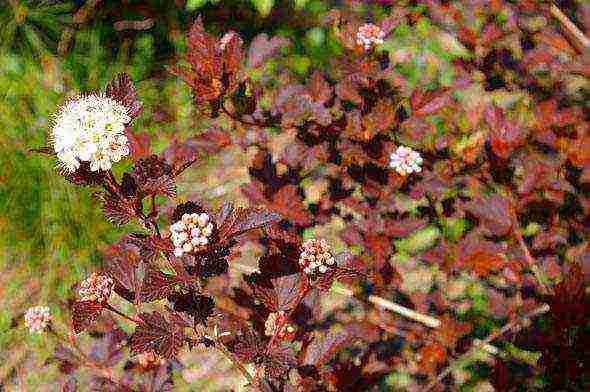
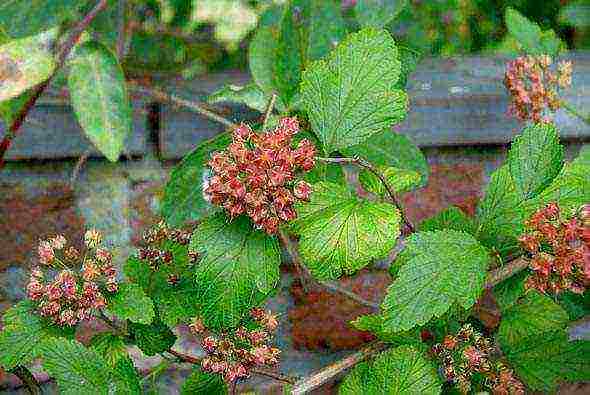
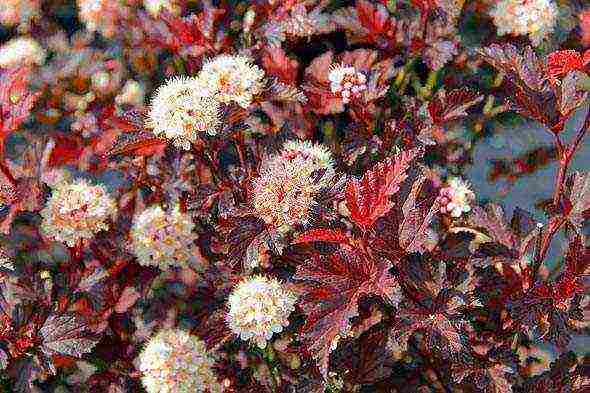
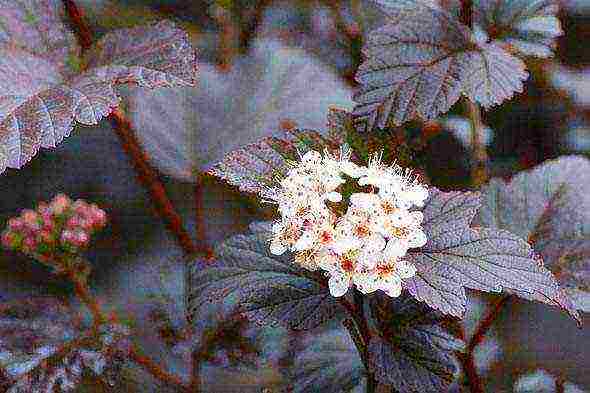

Bubbles (Physocarpus) is a deciduous shrub of the Pink family, which is decorative throughout the season. This unpretentious bush with lush inflorescences can be grown by a beginner. We will tell you about the features of growing a vesicle.
In landscape design, the viburnum bladder is especially popular. This plant has spreading and drooping branches, three- or five-lobed leaves (like viburnum), the color of which depends on the variety, and white or white-pink spherical inflorescences, from which it is impossible to look away in summer. In the fall, rather decorative and unusual leaflet fruits appear in place of flowers.
To enjoy this beauty on your site, you need to make very little effort.
Planting the bladder
It is best for beginners to choose seedlings with a closed root system. These plants can be planted from spring to autumn. And it is recommended to "settle" the seedlings of the vesicle with open roots in the garden only in autumn (in September), in extreme cases - in early spring, but then the plants take root less well.
The bubble plant prefers open, sunny areas. Tall trees should not grow near this place. By the way, varieties with green leaves develop well in partial shade, but a bright color can be achieved only in the sun.
In order for the plant to form a lush crown, and in the summer there are many inflorescences on the shoots, the soil on the site must be well-drained, loose, fertile (a mixture of garden soil, peat, sand and turf is suitable), loamy and without lime.
A hole for the bladder is dug in such a size that a seedling with an earthen clod can freely fit there. Fertile soil is poured into the hole 2 weeks before planting so that the earth has time to settle. When planting a seedling, the root collar should be at the same level as the soil surface.
The seedling is watered abundantly. If at the same time the earth subsides greatly, then it needs to be poured. To preserve moisture, a young vesicle is mulched with peat or humus.
This shrub is suitable for single and group plantings, but a hedge from a bladder tree looks best in the garden. To grow it, young seedlings are planted in a two-row way in a checkerboard pattern. The distance between the rows is 35 cm, and between the plants in the row is 45 cm.
Bladder care
The plant does not tolerate drought well, therefore, first of all, you need to take care of timely watering (in summer, on average, 2 times a week). But the earth is moistened early in the morning or in the evening and so that drops do not fall on the leaves and inflorescences. Otherwise, under the influence of the sun, burns may form on the plant. If the shrub is not mulched, then after watering the soil is loosened and weeds are regularly weeded.
When planting the bladder in fertile soil, you do not need to apply fertilizers, but after a few years, the plant begins to be fed 2 times a year. In the spring, use 0.5 liters of mullein and 1.5 tbsp. ammonium nitrate or 1 tbsp. urea (urea). All this is dissolved in 10 liters of water and poured under one plant. For shrubs over 10 years old, you will need about 15 liters of such fertilizer. In autumn, the bladderwort is fed with nitroammophos (2 tablespoons per 10 liters of water). 10-15 liters of fertilizer are consumed per bush.
Pruning and shaping the vesicle
Spring pruning should be both sanitary and formative. At the same time, all broken, diseased, frozen branches are removed, as well as those that grow inside the bush and thicken the crown. The remaining shoots are pruned so that the bush takes on an attractive shape.
In the fall, shearing the bladder is needed in order for the plant to winter better. At this time, all damaged and dry shoots are cut out, after which they are burned to destroy pests that like to winter on dry branches.
Rejuvenating pruning of a bush (on a stump) is done at the age of 5-6 years. At the same time, it is recommended to cover the sections on thick shoots with garden pitch so that fungi and bacteria do not penetrate there.
Bladder infections
The bladder practically does not get sick and is not damaged by insects. But if the plant lacks nutrients (in particular, iron and magnesium), then it may develop chlorosis... In this case, the leaf plate (excluding the veins) turns yellow, and the young shoots dry up. To save the shrub, it is watered under the root with Antichlorosis or Iron Chelate.
Wintering of the bladder
Adult plants winter well in the middle lane without shelter, but young seedlings are insulated in autumn: after pruning and mulching with peat (5-7 cm layer), they are covered with spruce branches. If an adult bladderworm has weakened immunity, and a frosty and snowless winter is expected, then it is better to carefully pull the shrub with twine and insulate it with a cap to shelter the plants for the winter or wrap the bush in spunbond.
How to propagate the bladder
The most popular is the reproduction of the vesicle cuttings before the plant begins to bloom. To do this, use young green shoots of the current year with a length of 10-15 cm. The lower cut on the handle is made just below the bud and at an angle of 45 degrees. The leaves are removed, only the top two are left and at the same time they are shortened by half.
Cuttings are placed for a day in a container with water, into which a root formation stimulator (Kornevin, Heteroauxin) is added.Then the cuttings are planted on a school bed in a mixture of sand and peat or rooted at home in a container. The container is covered with a film or a plastic lid, periodically ventilated and moistened with soil. In the spring, the cuttings are planted in a permanent place.
As you can see, grafting of the vesicle is not difficult. But if you want to make even less effort, then the plant can be propagated using layering.
In the spring, a healthy and strong shoot is chosen, the leaves are cut off (only the top of the head is left), placed in a pre-dug hole (10-15 cm deep) and pinned to the ground. A wooden peg is driven in next to it and the top of the rejected shoot is tied to it. The soil in the place of the layering is regularly moistened, and the next year, in early spring, the formed young bush is transplanted to a permanent place in the garden.
Also popular is this method of propagation of the vesicle, as dividing a bush... In spring or autumn, the bush is dug up and divided into several parts, each of which should have several shoots and a root lobe. Delenki are immediately seated so that their roots do not have time to dry out.
The gallbladder is propagated and seeds, which are sown in spring or autumn (necessarily after stratification). But this is a very laborious process. And varietal shrubs cannot be propagated in this way: they will not retain the characteristics of the mother plant.
The unassuming bubbly tree will brighten your garden from spring to late fall. The plant has attractive leaves, inflorescences, and fruits. Set aside a place for him in your summer cottage - and the spectacular shrub will not disappoint you!

The bladder will look great both as a free-standing shrub and as a hedge
The bubbly is a perennial ornamental shrub that is popular with gardeners due to its easy growing and maintenance, as well as excellent external qualities.
A hedge made of this shrub looks very impressive. It will become a decoration of any suburban area.
Landing
How the shrub will develop and grow depends on the choice of the place, time and soil for planting.
Seat selection
Here are some tips for choosing a site for planting the vesicle:
- It is recommended to plant a shrub in an open, well-lit place. In a darkened area, the plant does not take root badly, but the color of the leaves will eventually fade and become not as pronounced and bright as in the sun.
- It is not recommended to plant the bladder next to branched fruit trees.
- The plant is unpretentious to the soil. It is desirable that it be light, well let water and oxygen to the roots. If the land is not rich in minerals, it is recommended to feed the shrub.
Timing for boarding
Bubbles are most often planted in May or early June. Over the summer, the plant will have time to get stronger and prepare for the first winter.
It is risky to plant in our lane in the fall. If a cold snap sets in early and rainy cloudy weather, the shrub can take root badly and survive the winter badly.
Soil preparation
Before planting, the earth is well dug up, roots, pebbles, dried grass, leaves are removed and loosened.
The soil should be well drained, slightly acidic and free of lime.
Features of planting in open ground
The first vesicle bushes are recommended to be purchased in a specialized and proven store. This will ensure that the plant will take root well. The root system must be closed.
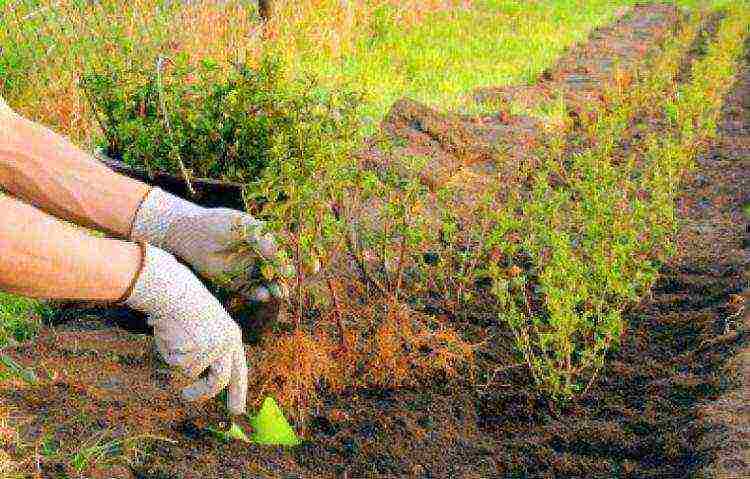
Given the tendency of the bladder to overgrow, leave as much space between the bushes as possible
- Before planting, they dig a deep hole (about 50 by 50 cm). A small layer of humus is placed on the bottom.
- The plant is carefully removed from the container in which it was located and moved into the pit in an upright position. The root collar is not covered with earth.
- The pit is covered with earth, lightly compacted and watered. It is advisable to mulch immediately after planting, sprinkling the ground under the plant with peat.
- There should be up to two meters of free space between the plants.
We grow Chinese lemongrass - instructions here.
Also read the article on the daylily, planting and caring for it.
Bladder care
Watering
The bubble plant loves regular, plentiful watering. The soil should dry well before the next watering. In hot weather, it is recommended to water more frequently.
Top dressing
Tips for feeding the vesicle:
- You need to fertilize the plant twice a season.
- In early spring, they are fed with nitrogen-containing fertilizer. For ten liters of water, take one tablespoon of urea and ammonium nitrate, half a liter of mullein.
- In the fall (before the onset of cold weather), fertilize with mineral complex fertilizers.
Preparing for winter
The plant tolerates winter well, if you follow the recommendations:
- Before frost, you need to mulch and add a small layer of humus, hay and peat. This will serve as a good shelter from severe frosts, and with the arrival of spring it will become food for the plant.
- Young plants (planted in the first year) need additional shelter.
Reproduction
Most often, the shrub is propagated by cuttings or by dividing the bush. This is done in late May or early summer (before flowering). With the help of seeds, the plant is rarely propagated, since the varietal characteristics of the shrub are lost.
Propagation by cuttings

The appearance of buds on the cuttings is a sign that it is time to plant the bladder on the site
Step-by-step instructions for grafting the vesicle:
- To propagate the plant by cuttings, first cut off healthy strong branches (2-3 internodes) with a sharp knife and clean them of leaves.
- The cuttings are slightly dried and planted in warm, clean sand.
- When the first buds appear on the cuttings, you can plant them on the site. Better to plant next to the plant from which the cuttings were taken.
Dividing the bush
Only an adult, healthy, well-developed bush is suitable for this.
The separated part from the bush is treated with a solution of potassium permanganate and planted in a new place.
It is better to shorten the branches in a new place a little in order to give the plant a good root and not waste energy on the formation of leaves.
Pruning
Bush pruning can be sanitary or decorative (or molding).
- During sanitary pruning, damaged, dry, broken branches are removed. Most often it is done in the spring and early fall.
- The molding is done after flowering. Shoots are cut by about 1/3 of the crown size.
- A hedge from a vesicle needs to be pruned (sheared) 1-2 times during the growing season. The first haircut takes place in April, the next as needed.
Also read about clematis, planting and caring for it.
And here you will find information on growing a climbing rose.
Pest and disease control
The shrub has excellent immunity and is extremely rarely exposed to diseases or pest attacks.
Sometimes from an excess of moisture (especially on heavy soil) root rot can occur. In this case, you need to dig up the plant, remove the affected parts, process with potassium permanganate and plant in a new place.
Varieties
Each variety of bladderworm differs in its individuality. Let's consider the most popular ones:
- Diabolo Is the most preferred variety. Has good decorative qualities. It features beautiful maroon leaves that will decorate various landscape compositions.
- Luteus - a variety with good and fast growth. Has a playful leaf color. When blooming, they are yellow with an orange tint, turn green in June, and golden in autumn. Inflorescences are white.
- Dart's Gold - wide shrub, rounded, reaching 3 meters. Leaves are yellow with a golden tint or lemon. Inflorescences are white or with a pink tint.
- Center glow - shrub with expressive leaf color. At the edges, the leaves are burgundy, and in the center are yellow and lemon. The color is especially pronounced in young leaves. With age, the color changes and becomes like a Burgundy wine, only a slight yellow tint remains at the center.
- Red baron - has an expressive red leaf venation. The shrub grows up to 2 meters. The flowers are pink.
You can see photos of these varieties in the gallery:
Application in landscape design
The bubble plant will be a worthy decoration for any landscape design. It can be used to decorate small rocky paths near the house. You can create a decorative hedge.

The bubble plant will be an excellent solution for a hedge
Plants planted alone next to benches or an artificial reservoir look good.
With the right foliage shade, the bubblegum will look great next to a variety of vibrant flowers.
Bubble plant every year attracts more and more attention of gardeners. It has good decorative, aesthetic qualities and is easy to maintain.
If you give him your care and attention, he can become a real decoration of your garden plot.
Jul 21, 2015Elena Tymoshchuk


